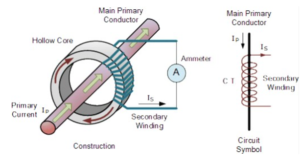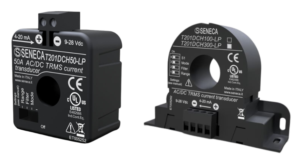Current transducers – also known commercially as CTs (current transformers) – are essential components for low and medium voltage energy monitoring. These devices, strengthened by their accuracy and ease of installation, allow the signal from the primary source to be converted and made available to other energy monitoring instruments, such as energy meters, network analyzers, power quality meters and other transducers. Applications range from current and absorption measurements for electric motors and control devices, to the detection of energy consumption, to the normalization of electrical signals into standard signals usable by data acquisition systems.
In particular, current transformers reduce high voltage currents to much lower values, safely monitoring the actual electric current flowing in a transmission line using a standard ammeter.
Current transformers can reduce current levels from thousands of amps down to a standard output of a known ratio, typically to 1 or 5 amps for normal operation.

According to the primary winding we distinguish:
-
Toroidal CTs (do NOT contain a primary winding. The line carrying the current flowing in the network is threaded through a window or a hole in the toroidal transformer).
-
Wire-wound CTs (The primary winding of the transformer is physically connected in series with the conductor carrying the measured current flowing in the circuit).
-
Bar-type CT (This type of transformer uses the actual cable or bus bar of the main circuit as the primary winding).
-
Cross section of the through-hole.
-
Transformation ratio.
-
Accuracy class in relation to the power required by the instrument connected to the transformer secondary.
SENECA solutions
SENECA AC/DC Current Transducers T201 Series are devices able to convert the measured current value (up to 600 A) into an industrial standardized 4..20 mA or 0..10 V signal. Most models of the T201 Series are UL certified and feature low power consumption, convenient measurement scales settable via DIP-switch or software, and high accuracy. 16 models are available with different measuring principles: rectified average, magnetic balance (with patented technology), Hall Effect or TRMS with bipolar input range.
Some models are equipped with RS485 ModBUS RTU interface and Micro USB port. The T201 range is appreciated for the versatility of power supply (even on measuring loops) and the low power consumption, which together with the negligible thermal drift, makes it extremely reliable.
Visit our website:
www.logicbus.com




sales@logicbus.com | support@logicbus.com | +1 619 616 7350 | Start conversation


